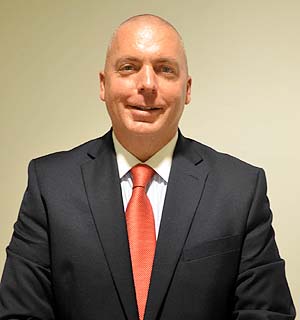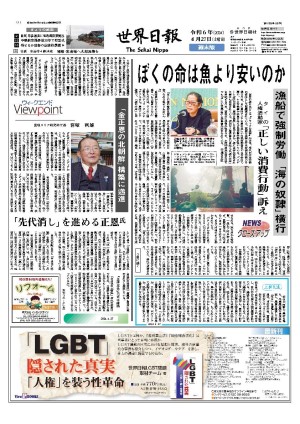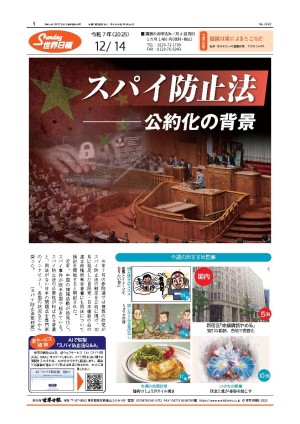地に堕ちたテレ朝「報ステ」<English付>
エルドリッヂ研究所代表・政治学博士 ロバート・D・エルドリッヂ
 基地映像の印象操作
基地映像の印象操作
レーザー照射犯に情状酌量
日本では歴史上かつてないほどメディアに対する国民の目は厳しくなっている。朝日新聞が“従軍慰安婦”問題で20年以上にわたって意図的に嘘の証言を伝えたことにより、メディアに対する失望と不満は最高潮に達した。
こうした状況の中で、日本のメディアは簡単に見抜くことができる誤報や偽証を避けるように特に細心の注意を払っていると想像できるが、どうも、古い様式や根強いイデオロギーから抜け出すのは難しいようだ。
左派の朝日新聞系列のテレビ朝日の「報道ステーション」は12月7日、普天間飛行場を離着陸する米軍機にレーザー照射したことを認めた日本国内のテロリストが逮捕されたという短い、本当にとても短いニュースを伝えた。
この人物は過去、パイロットに向けて何度もレーザー光を照射し、警察が宜野湾市の住居を家宅捜索したところレーザーポインターが見つかった。このニュース自体が不穏なものだが、この事件に対する報道は事件と同じぐらいひどいものだった。
第一点目は、この日本人テロリストの行為を扱ったニュースの時間はたった45秒だったことだ。
第二点目は第一点目に関連しているが、このニュースに関するコメントは一言もなかった。番組キャスターの古舘伊知郎氏やその女性のアシスタントもそうだが、番組中にニュースについて追加情報や洞察を提供して一種の解説を加えるはずの憲法学教授の専属コメンテーターも無言を貫いたことだ。
古舘氏は保守あるいは中道保守的だとみなされるものに対しては批判を繰り返すことで知られているが、今回のテロ行為に対してはコメントしないことを選んだ。このようなノーコメントは驚くべきことだ。そのうえ、出演している、件の教授は憲法の専門家なのであり、法治社会でなぜテロリズムを容認すべきではないかを説明することは視聴者の役に立ったはずだ。しかし、彼は何も言わなかった。このことも不可解である。
さらに憂慮される第三点目は、同番組において、このニュースの優先順位が低く設定されたことだ(11番目)。フランスにおける右派勢力の躍進のニュースはこの日本でのテロ行為よりも重要視された。
非常に懸念される第四点目は、「報道ステーション」がどのように普天間飛行場の映像を使用したかということだ。普天間飛行場にいかに航空機がたくさんあるかというイメージを作りあげるための“イメージ操作”を行っている。イメージ操作とは、情報操作をすることで、ある特定の状況についての印象を作り上げる手段のことだ。
テレビ朝日は2つの方法を使った。両方とも、過去の映像を使った。KC130空中給油機15機がVMGR152という部隊を編成していた時のものだが、この部隊は1996年の「沖縄に関する日米特別行動委員会(SACO)」の合意に基づいて2014年7月に海兵隊の岩国基地に既に移転した。この映像だけでも古いことが分かる。
とりわけ、テレビ朝日はヘリコプターCH46の映像を使った。わずか数秒流れた映像だが、筆者の記憶が正しければ2つの部隊を見せた。この映像は両部隊が普天間の任務に就いていた3年以上前のものだ。それだけでなく、一時的にしか駐留していなかったヘリの映像を流すことで、普天間飛行場にはたくさんの航空機が駐留しているという印象付けをしようと試みたものだと分かる。
このイメージ操作は、一般的な視聴者には分かりづらい(イメージ操作がいかに効果的かを示す良い例だ)。しかし、基地の運用、基地を取り巻く政治環境、策略的メディアに詳しい人にとって、本当に腹立たしいものだ。テレビ朝日は地元の系列局があり、最近の普天間飛行場の映像を所有しているはずである。
意図的に制作されたことは間違いない。もっと心配なのは、テレビ朝日が間接的にテロ行為を容認していると思われてもおかしくない報道だ。つまり、(そもそも沖縄出身ではない)平岡克郎容疑者の犯行は、基地に航空機が過大に駐留しているせいであるかのような伝え方だった。
テレビ朝日が無理やりテーマを不正確に伝えることを見てきたことからすると、後で「うっかりミス」だったと(再度)弁明するとしても驚きではない。
こうした行為は人々のメディア不信を招く。意図的な偏向報道が行われていることを知っているので、もう何年も報道ステーションを見ていない。12月上旬にたまたま見たときはすぐに、よくも無責任になれるものだと再び感じた。テレビ朝日とほかのメディアの無責任さは沖縄問題を悪化させる最大要因だ。約半年前に初めて書いたビューポイントで指摘した問題だが、悲しいかな、行いを改めたり責任を持つことに失敗している。
新年を迎えるにあたって願うことは、メディアが無知やイデオロギーにとらわれるのではなく、情報や啓発において尊敬される客観的な発信元になることである。
Hodo Station/Terebi Asahi Reaches a New Low
Robert D. Eldridge, Ph.D.
Public scrutiny toward the media is the highest it has ever been in Japan. Disappointment and dissatisfaction reached an all-time low following the Asahi Shimbun’s revelations about its intentionally misrepresenting the comfort women issue using false testimonies in its stories for more than two decades.
Amid this situation, the reader would think the national media would be especially careful to avoid misrepresenting or misportraying situations that can easily be discovered. But it seems old patterns and ingrained ideology is hard to break free from.
On December 7 this month, Terebi Asahi, a broadcast company owned by the left-wing Asahi Shimbun, did a short—very short—story on the arrest of a self-admitted domestic terrorist who is believed to have used lasers on U.S. aircraft flying into and around Marine Corps Air Station Futenma.
The news itself was not only disturbing—that he used lasers on our pilots previously and the police found lasers when they searched his home in Ginowan City—but the way it was reported was almost as bad.
First was the length of time devoted to the story—an act of domestic terrorism—was only about 45 seconds.
Related to the first point is the next one: that the story included no commentary by either the host, Furutachi Ichirō, his assistant, or the beholden professor of constitutional law who was on the show to provide additional information and insights as sort of an interpreter of the news.
This lack of commentary was particularly curious in that Furutachi is known for going on and on when criticizing anything considered conservative or center-right but chose not to comment on an act of terrorism. It is extraordinary that he did not. Furthermore, the professor in question is a constitutional expert and would have been helpful in explaining why terrorism cannot be tolerated in law-abiding societies. And yet he did not speak. This, too, is inexplicable.
Moreover, and the third point of concern was that the story was placed very low in priority on the show, 11th, to be precise. France’s supposed shift to the right politically was given higher priority than an act of domestic terrorism in Japan.
The fourth point that was of great concern was how Hodo Station employed footage of MCAS Futenma. The way it did so was done to create the image that there are many aircraft at Futenma, a trick known as “image sōsa,” or creating an impression about a certain situation through manipulating information.
How Terebi Asahi did it was through two ways. In both cases, it used old footage. Once scene showed the fifteen KC-130s making up VMGR-152, which moved to MCAS Iwakuni in July 2014 (as part of the U.S.-Japan Special Action Committee on Okinawa recommendations of 1996), still being at Futenma. That image alone showed that the footage was old.
On top of this, Terebi Asahi showed CH-46s still being at MCAS Futenma, and while that scene appeared only a few moments, my recollection is that it showed two squadrons. Not only was the footage, therefore, more than three years old (when both squadrons were still assigned to Futenma), but it used footage when there was more than the usual amount of aircraft there—a temporary occurrence—thus attempting to give the impression of there being a lot of aircraft there.
This image manipulation was probably not easily recognizable to the average viewer (and thus explains why it can be so effective). However, for someone familiar with the operations of the base and politics surrounding it, as well as with the deceitful methods of the media, it was truly disgraceful, particular as Terebi Asahi has a local affiliate here and certainly has more recent footage than what it presented.
There is no doubt this was done intentionally. What is more worrisome, however, is whether Terebi Asahi was indirectly endorsing the terrorism, by suggesting that the suspect, Hiraoka Katsurō, who is not even from Okinawa to begin with, was justified in his actions due to the implied heavy presence of aircraft at the base.
Having witnessed Terebi Asahi go out of its way to misrepresent subjects it was reporting about, it would be surprising if it said (again), it was an “honest mistake.”
Actions like this feed the public’s mistrust of the media. I have not watched Hodo Station in months or years due to its intentionally biased reporting, but when I did see it earlier this month, I saw again firsthand how irresponsible it can be. Its irresponsibility, and that of other media outlets, are the biggest factors in the worsening of the Okinawa problem, and sadly fail to clean up their act or hold themselves accountable, an issue I first wrote in these pages about six months ago.
My new year’s wish, therefore, is that the media becomes a respected, objective source of information and enlightenment, rather than of ignorance and ideology.





